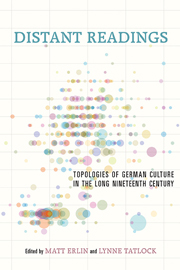16 results
11 - Embedded Ideas: Revolutionary Theory and Political Science in the Eighteenth Century
- from Part II - Case Studies in the Digital History of Ideas
-
-
- Book:
- Explorations in the Digital History of Ideas
- Published online:
- 09 November 2023
- Print publication:
- 23 November 2023, pp 225-255
-
- Chapter
- Export citation
7 - Enlightenment Entanglements of Improvement and Growth
- from Part II - Case Studies in the Digital History of Ideas
-
-
- Book:
- Explorations in the Digital History of Ideas
- Published online:
- 09 November 2023
- Print publication:
- 23 November 2023, pp 140-162
-
- Chapter
- Export citation
Chapter 22 - The Affordances of Mere Length
- from Part IV - Theories
-
-
- Book:
- The Cambridge Companion to the American Short Story
- Published online:
- 11 May 2023
- Print publication:
- 25 May 2023, pp 341-357
-
- Chapter
- Export citation
11 - The Novel as Data
- from Part II - How Does The Novel Work?
-
-
- Book:
- The Cambridge Companion to the Novel
- Published online:
- 28 June 2018
- Print publication:
- 28 June 2018, pp 189-216
-
- Chapter
- Export citation
I - Quantification
-
- Book:
- Distant Readings
- Published by:
- Boydell & Brewer
- Published online:
- 05 April 2014
- Print publication:
- 01 May 2014, pp 27-28
-
- Chapter
- Export citation
Frontmatter
-
- Book:
- Distant Readings
- Published by:
- Boydell & Brewer
- Published online:
- 05 April 2014
- Print publication:
- 01 May 2014, pp i-iv
-
- Chapter
- Export citation
6 - The Werther Effect I: Goethe, Objecthood, and the Handling of Knowledge
- from II - Circulation
-
-
- Book:
- Distant Readings
- Published by:
- Boydell & Brewer
- Published online:
- 05 April 2014
- Print publication:
- 01 May 2014, pp 155-184
-
- Chapter
- Export citation
Selected Bibliography
-
- Book:
- Distant Readings
- Published by:
- Boydell & Brewer
- Published online:
- 05 April 2014
- Print publication:
- 01 May 2014, pp 347-370
-
- Chapter
- Export citation
III - Contextualization
-
- Book:
- Distant Readings
- Published by:
- Boydell & Brewer
- Published online:
- 05 April 2014
- Print publication:
- 01 May 2014, pp 257-258
-
- Chapter
- Export citation
1 - Burrows's Delta and Its Use in German Literary History
- from I - Quantification
-
- Book:
- Distant Readings
- Published by:
- Boydell & Brewer
- Published online:
- 05 April 2014
- Print publication:
- 01 May 2014, pp 29-54
-
- Chapter
- Export citation
Acknowledgments
-
- Book:
- Distant Readings
- Published by:
- Boydell & Brewer
- Published online:
- 05 April 2014
- Print publication:
- 01 May 2014, pp vii-viii
-
- Chapter
- Export citation
Contents
-
- Book:
- Distant Readings
- Published by:
- Boydell & Brewer
- Published online:
- 05 April 2014
- Print publication:
- 01 May 2014, pp v-vi
-
- Chapter
- Export citation
Contributors
-
- Book:
- Distant Readings
- Published by:
- Boydell & Brewer
- Published online:
- 05 April 2014
- Print publication:
- 01 May 2014, pp 371-374
-
- Chapter
- Export citation
II - Circulation
-
- Book:
- Distant Readings
- Published by:
- Boydell & Brewer
- Published online:
- 05 April 2014
- Print publication:
- 01 May 2014, pp 153-154
-
- Chapter
- Export citation
Index
-
- Book:
- Distant Readings
- Published by:
- Boydell & Brewer
- Published online:
- 05 April 2014
- Print publication:
- 01 May 2014, pp 375-386
-
- Chapter
- Export citation

Distant Readings
- Topologies of German Culture in the Long Nineteenth Century
-
- Published by:
- Boydell & Brewer
- Published online:
- 05 April 2014
- Print publication:
- 01 May 2014

